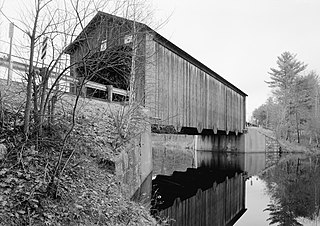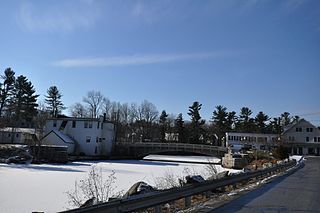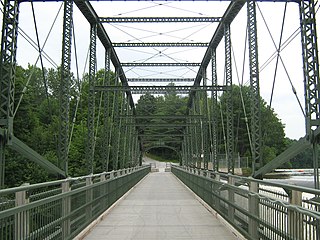
The Columbia Bridge is a covered bridge, carrying Columbia Bridge Road over the Connecticut River between Columbia, New Hampshire and Lemington, Vermont. Built in 1911–12, it is one of only two New Hampshire bridges built with Howe trusses, and is one of the last covered bridges built in the historic era of covered bridge construction in both states. It was listed on the National Register of Historic Places in 1976.

The Bardwell's Ferry Bridge, built in 1882, is a historic lenticular truss bridge spanning the Deerfield River between the towns of Shelburne and Conway in Franklin County, Massachusetts. The bridge is listed on the National Register of Historic Places and is designated as a Massachusetts Historic Civil Engineering Landmark by the American Society of Civil Engineers.

The Golden Hill Bridge is a historic bridge on Golden Hill Road over the Housatonic River in Lee, Massachusetts. It is a lenticular pony truss bridge built c. 1885 by the Berlin Iron Bridge Company, and is the state's oldest surviving bridge of this type. It is one of only five Berlin Co. bridges in the Berkshires, and is the only known surviving bridge to implement modifications to the pony truss design patented by William O. Douglas in 1885. The bridge was listed on the National Register of Historic Places in 1994.

The Glen Falls Bridge is a historic bridge that formerly carried Brunswick Avenue over the Moosup River in Plainfield, Connecticut. Built in 1886 by the Berlin Iron Bridge Company, it is one of a shrinking number of surviving 19th-century lenticular truss bridges in the state. The bridge was listed on the National Register of Historic Places in 1999. It has been closed to all traffic for many years.

The Bement Covered Bridge is a historic wooden covered bridge on Center Road over the Warner River in Bradford, New Hampshire. A Long-truss bridge, it was built in 1854, and is one of New Hampshire's small number of surviving 19th-century covered bridges. It was listed on the National Register of Historic Places in 1976.

The Contoocook Railroad Bridge is a covered bridge on the former Contoocook Valley Railroad line spanning the Contoocook River in the center of the village of Contoocook, New Hampshire, United States. It is referred to in the National Register of Historic Places as the Hopkinton Railroad Covered Bridge, for the town of Hopkinton, New Hampshire, in which the village of Contoocook is located.

The Turn-of-River Bridge, also known as Old North Stamford Road Bridge, is a single-span lenticular pony truss bridge built by the Berlin Iron Bridge Company in 1892. It was listed on the National Register of Historic Places in 1987. It formerly brought the Old Stamford Road across the Rippowam River, but is now open only to pedestrian traffic, as the road ends shortly before the bridge.

The Hancock–Greenfield Bridge is a historic covered bridge carrying Forest Road over the Contoocook River at the town line between Hancock and Greenfield, New Hampshire. The New Hampshire Department of Transportation covered bridge database refers to it as County Bridge. Built in 1937, it is the first wooden covered bridge in the northeastern United States to use modern engineering techniques. The bridge was listed on the National Register of Historic Places in 1981.

The Contoocook Railroad Depot is located in Hopkinton, New Hampshire, United States, in the village of Contoocook. The depot was completed in 1849 as one of the first substantial railroad passenger stations west of Concord on the Concord and Claremont Railroad. The building is one of the best preserved of a small number of gable-roofed railroad stations surviving from the first decade of rail development in New Hampshire. The station exemplifies the pioneering period of rail development in the state.

The Bog Bridge, also known as the Cilleyville Bridge, is a historic covered bridge in Andover, New Hampshire. Built in 1887 and located off New Hampshire Route 11 west of Andover center, the Town lattice truss bridge is one of New Hampshire's few surviving 19th-century covered bridges, and is relatively little altered since its construction, having had its roof replaced and an abutment reconstructed. The bridge was listed on the National Register of Historic Places in 1989.

The Keniston Bridge is a historic covered bridge in Andover, New Hampshire, carrying Bridge Street over the Blackwater River. Built in 1882, it is of Town through truss construction, and is one of the few surviving 19th-century covered bridges in the state. It is also one of the only ones whose sides are not fully sheathed, exposing the trusses. The bridge was listed on the National Register of Historic Places in 1989.

The Sulphite Railroad Bridge, also known locally as the Upside-Down Covered Bridge is a historic railroad bridge in Franklin, New Hampshire. The bridge was built circa 1896-7 to carry the tracks of the Boston and Maine Railroad across the Winnipesaukee River between Franklin and Tilton. The bridge is believed to be the only surviving "upside down" covered railroad bridge in the United States, in which the rail bed is laid on top of the bridge roof, whose purpose is to shelter the trusses below. The bridge was listed on the National Register of Historic Places in 1975. The bridge, unused since 1973, is not in good condition, having been subjected to graffiti, vandalism, and arson, as well as the elements.

The Goffstown Covered Railroad Bridge was a rare railroad covered bridge in Goffstown, New Hampshire. It was built in 1901 by the Boston and Maine Railroad, on the site of an earlier bridge built in 1850 by the New Hampshire Central Railroad, and carried its tracks across the Piscataquog River in the center of Goffstown. The bridge was listed on the National Register of Historic Places in 1975. It was destroyed by arson in 1976, as would later be the case with the Hillsborough Railroad Bridge in 1985.

The Hillsborough Railroad Bridge was a historic covered railroad bridge spanning the Contoocook River in Hillsborough, New Hampshire. Built in 1903 by the Boston and Maine Railroad, it was destroyed by arson in 1985. The bridge was listed on the National Register of Historic Places in 1975. At the time of its nomination it was one of six covered railroad bridges in the state; it and at least one other were destroyed by the actions of arsonists.

The Pier Bridge is a historic covered bridge in Newport, New Hampshire. Originally built in 1907 to carry the Boston and Maine Railroad across the Sugar River, it now carries the multi-use Sugar River Trail, which was built on the abandoned right-of-way. It is one of a modest number of historic covered bridges in New Hampshire, and is named for the fact that it has a central pier. The bridge was listed on the National Register of Historic Places in 1975.

The East Shoreham Covered Railroad Bridge is a historic covered bridge spanning the Lemon Fair River near East Shoreham, Vermont. Built in 1897 by the Rutland Railroad Company, it is the state's only surviving example of a wooden Howe truss railroad bridge. It was listed on the National Register of Historic Places in 1974.

The Douglas & Jarvis Patent Parabolic Truss Iron Bridge is a historic bridge across the Missisquoi River in Highgate, Vermont. Located at the end of Mill Hill Road, it is at 215 feet (66 m) one of the longest bridges of its type in the northeastern United States. It was built in 1887, and was listed on the National Register of Historic Places in 1974.

The Old Boardman Bridge, formerly Boardman Bridge, is a historic lenticular truss bridge, which used to carry Boardman Road across the Housatonic River in New Milford, Connecticut. Built from 1887 to 1888 out of wrought iron, it is one of the state's three surviving examples of this bridge type, and along with Lover's Leap Bridge, one of two in New Milford. It was listed on the National Register of Historic Places in 1976. The bridge was closed to vehicles in 1984 and to pedestrians in 1985; however, the Town of New Milford is seeking to restore it and reopen it to pedestrian traffic.

The Melrose Road Bridge is a historic bridge at the western end of Melrose Road in East Windsor, Connecticut. Built in 1888, it is one of a small number of surviving 19th-century lenticular pony truss bridge in the state. It was listed on the National Register of Historic Places in 1999. It has been closed for many years, and lacks stringers and decking.

The Red Bridge is a historic bridge spanning the Quinnipiac River near Oregon Road in Meriden, Connecticut. It was built in 1891 by the Berlin Iron Bridge Company, and is one of a small number of surviving lenticular truss bridges in the state, and was listed on the National Register of Historic Places in 1993. The bridge is open to pedestrian traffic only.























